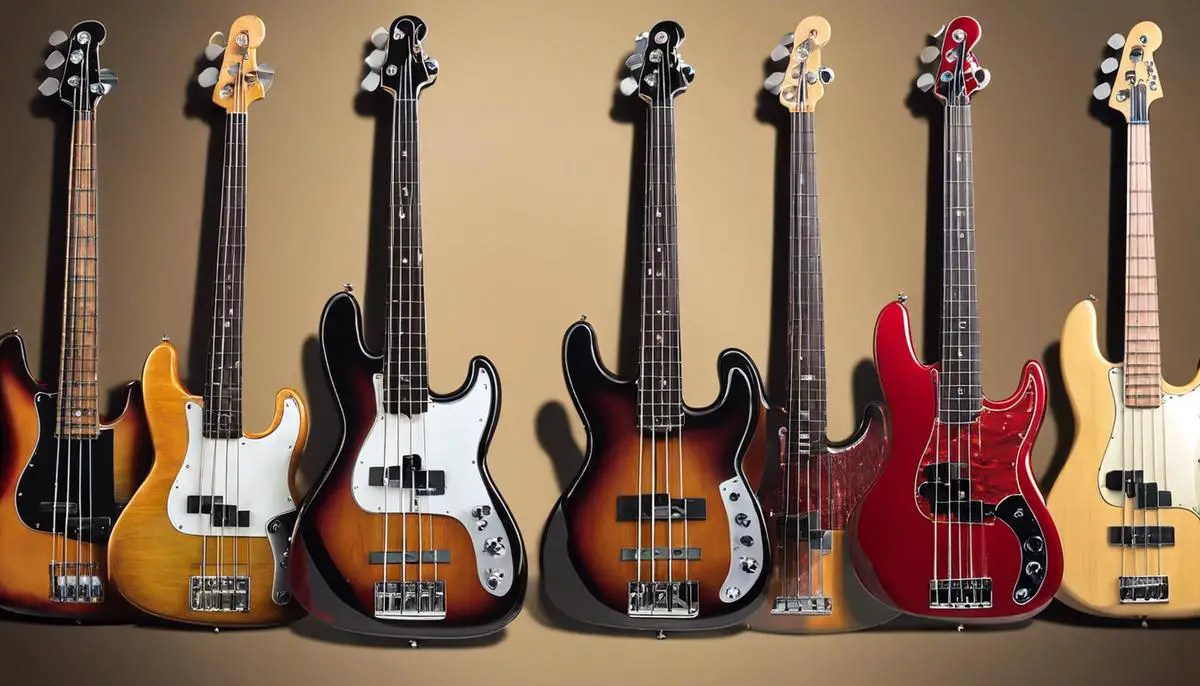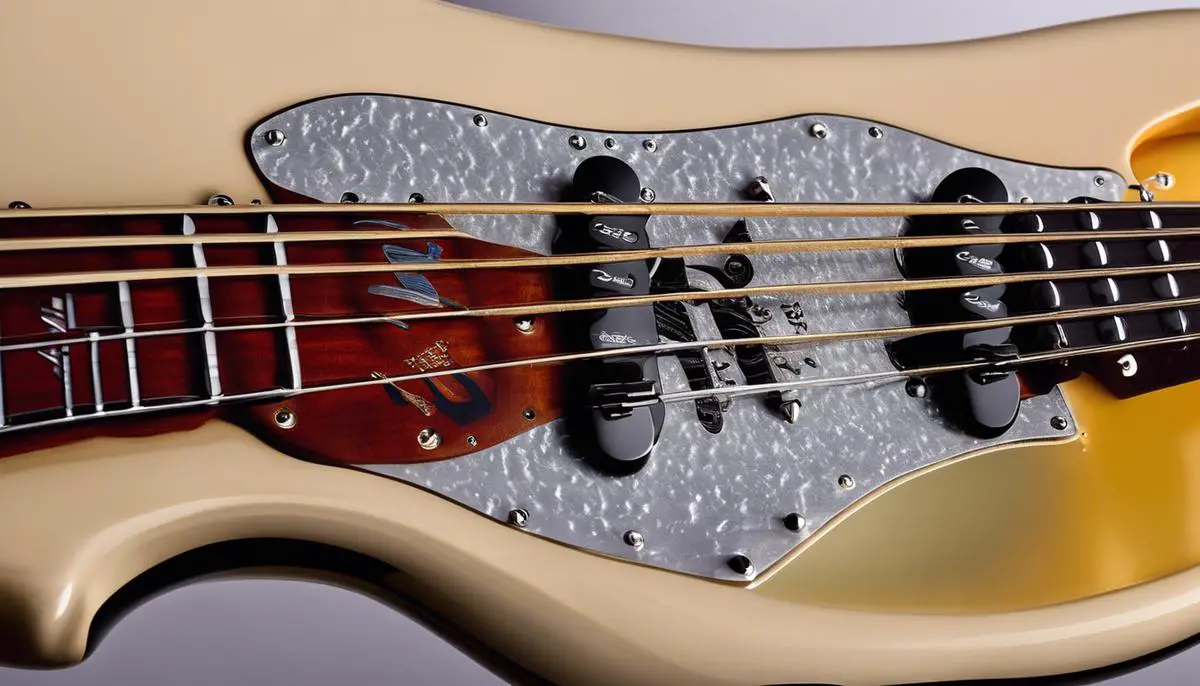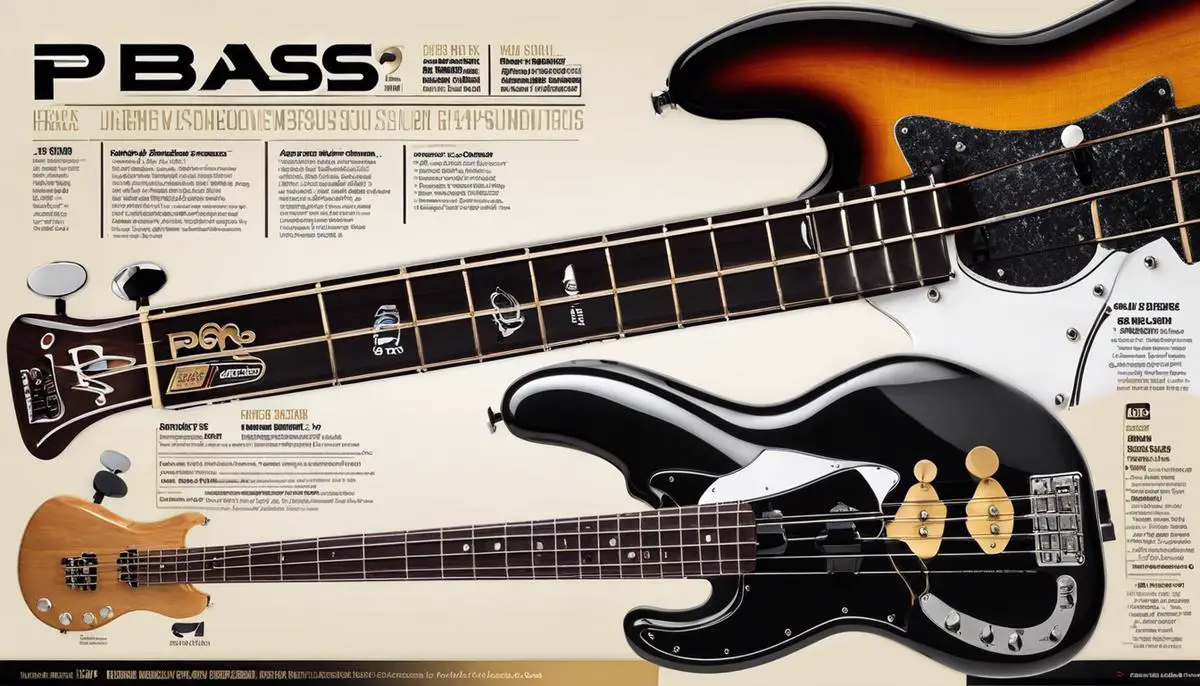The Precision Bass, colloquially known as the P Bass, has played an integral role in the evolution of music since its inception. The distinctive, resonant P Bass sound, characterized by warmth and an unmistakable punch, resonates through decades of music history, influencing a range of genres and contributing to the signature sound of countless artists.
Unplugging the mystique surrounding its iconic timbre necessitates a journey that traces back its rich history, dissects its technical nuances, and acknowledges its perpetuating influence on contemporary music.
Table of Contents
History and Evolution of Precision Bass Sound
Few musical inventions ignite passion and admiration in the hearts of musicians and fans like the Precision Bass, or as it is affectionately known, the P Bass. Launched in 1951 by Leo Fender, this iconic beauty reshaped the world of rock ‘n’ roll, jazz, funk, and pop as we know it today.
Like a shimmering relic of musical history, the Precision Bass traces a mesmerizing musical journey, demonstrating an evolution in sound that has encompassed the airwaves and beyond. This evolution has invariably profoundly impacted the music industry, fostering a sonic revolution pulsating louder than ever.
The P Bass is often heralded as the first widely accepted and mass-produced electric bass guitar. At its initial appearance, the instrument was nothing short of ground-breaking. An electric bass that offered perfect intonation and challenging guitar-like frets was a novelty. The resulting sound was punchy, rich, and powerful. It was a thundering announcement of the dawn of a new era. The rockabilly of the ’50s gloated with the robust tone of the Precision Bass, the sound that would become the backbone of countless classic tracks.
Fast forward to the 60s and 70s, the age of experimentation, and the P Bass adapted. With the buzz of psychedelic rock, heavy metal, and progressive rock filling up the charts, the instrument’s sound grew grittier and more robust. The P Bass was central to the psychedelic whirlwind of Pink Floyd and Jimi Hendrix, lending its full-bodied resonance to revolutionary vibrations.
When the intoxicating rhythm of funk and disco cascaded down music avenues in the ’70s and ’80s, the P Bass was there, pounding out relentless thumping sounds that compelled people to hit the dance floor enthusiastically. Across trans-continental music cultures, it was not ignorant of the bass-driven reggae tremors from Jamaica or the mesmerizing momentum of Afrobeat. A bassline from a Precision Bass had the power to send a shockwave through any crowd without the need for translation.
The versatility of the P-Bass was demonstrated once more as music ascended into the era of grunge, pop, and hip-hop in the late 20th and early 21st century. Whether it was adding depth to Nirvana’s raw angst, bracing the melodic temperament of pop ballads, or bursting in sync with the audacious beats of hip-hop, the P Bass held the fort with its distinctive sound.
Today, the P Bass sound continues to evolve, morphing and adapting to the innovative styles of modern-day music genres. Reimagining itself time and again while remaining charmingly recognizable, the P Bass sound remains essential to the foundation of most music. This instrument of change has been a constant muse to bassists, allowing them to experiment, create, and make their mark within their chosen genre.
While the P Bass started as a simple attempt to amplify the bass sound, it has become an irreplaceable tool in the music industry. The ramifications of its invention go beyond just a change in tone and resonance. The P Bass sound fueled the growth of musical experimentation and revolutionized how music was crafted and performed. It enriched the musical landscape, one bassline at a time, and led us into an audacious adventure of sound. As we look back at this journey, we can only nod in admiration, captivated by the fascinating evolution of the P Bass sound and its undeniable imprint on the music industry.

Technical Aspects of P-Bass Sound
We are unraveling the mystique of the core epitome of the P-Bass sound, which canons us into the world of musical technicalities. Key elements of that deep, resonating tone we associate with P-Bass light up our curiosity like neon letters on a marquee sign. Let’s focus on every sympathy of eccentric detail and the distinctive characteristics that shape the ‘solid gold’ P-Bass sonic identity.
The heart of the P-Bass sound lies in a precision-pieced, split-coil pickup. A single-coiled pickup is an artist equipped with symmetry tools, creating powerful, punchy sounds and potent tonal quality. However, the split-coil variety in the P-Bass is akin to a duet of artists, each harnessing half of the sound spectrum and uniting them bravely into a resonating, musical harmony. This resonating chorus produces a broad-bodied, balanced sound that pays homage to the decadent fundamentals while promoting the resonating overtones.
This split-coil pickup sits right in the middle of the harmonic series of each string, delivering a sweet-spot blend of depth and clunk, embodying that distinctive punchy attack and assertive growl. It rhythmically peals out a sound that’s a compelling, unique blend of melodic warmth and roaring grit. The ardent dance of harmonic spectrums is that magic, that P-Bass secret.
Yet, layered within this dance are the subtleties of construction: the larger-than-average neck, the alder or ash body, and the maple or rosewood fingerboard. These design intricacies combine to shape the sound characteristics further. Mellow tones hum from the rosewood, maple echoes bright harmonic overtones, and the hearty thud from a holistically crafted ash or alder body rounds out this sound symphony.
The P-Bass’s stock flatwound strings add another dimension to this sound sculpture. They oxy-acetylene the brightness into a more warm, pleasant growl, a wealthier, milder, more grounded tone that resonated through the strings of Paul McCartney’s, James Jamerson’s, and Carol Kaye’s P-Basses and through our hearts, stirring the rhythm of the eras.
This captivating symphony of sound, an aesthetic balance of warmth, roundness, and grit, defines the Precision Bass. Precision and Bass, indeed! It’s a sonic landscape sculpted by passion, bred in innovation, and shaped on the vast canvas of diverse genres.
From the chords of funk and jazz to the beats of punk and metal, P Bass embodies tonal precision, technical mastery, and historicity, taking all on a euphonic journey, one bassline at a time. The depth of its bass tone is unmistakable, and the breadth of its influence is undeniable, solidifying the P Bass sound not just as a cornerstone but as a pulsing heartbeat in the music realm. This is the distinct beauty of the Precision Bass sound. An audacious symphony that ignites the strings and sings to the soul.

P Bass Sound in Contemporary Music
The P Bass sound stands as a formidable element in the world of music, its unique tone reaching out across different genres and manifesting various atmospheric undertones. By examining its current role, one can witness the P Bass sound’s ageless beauty as it inspires and shapes the contemporary music scene.
Delving into modern rock, its landscape seems painted with bold strokes of the P Bass sound. One can hear its unvarnished roar throbbing in the baselines, providing an unrivaled tone that anchors the band’s sound. The P Bass’s presence isn’t solely confined to the hard-hitting realm of rock; it permeates softer musical domains, too. It manifests in alternative music, nestling itself in the eclectic composition and enhancing the musical narrative with its robust and flexible tone.
With its rustic charm and nostalgic feel, country music also appreciates the contribution of the Precision Bass. It provides a meaty low end that lays a foundation for twanging banjos and crying steel guitars, perfectly blending rustic aesthetics with modern versatility.
Transitioning into modern pop, the signature growl of the P Bass forms the phat, groovy baselines that crowd the genre, serving up a tasty melodic platter. Marrying depth and punchiness, it provides catchy hooks that engage listeners and induce foot-tapping pleasure.
Emerging from the shadowy depths of electronic music, the throbbing energy of the P Bass sound makes itself undeniably known. Creating pulsating baselines gives electronic and synth-based genres the grit they need for their powerful beats.
Always ready to embrace and innovate, jazz music finds the P Bass a bedfellow in its ensemble. The contradiction of the P Bass’s melodic, emotional warmth and gnarly grit makes it a compelling dance partner for smooth saxophones and sultry voices.
Moving to the world beat, the P Bass sound intersects with the vibrant rhythms of Afrobeat and Reggaeton. Here, it binds energetic percussion to angular guitars, creating a recognizably funky conversation that invites some dance-floor severe action.
The P Bass sound is essential for producers and artists across multiple genres in music creation. It’s a sonic shapeshifter, helpful in creating an array of soundscapes found in film scores, sound design, and ambient music.
Indeed, with its diversity of tone and texture, the Precision Bass sound continues to prove itself an integral musical chameleon. Its unrelenting versatility and adaptability make its influence as strong as ever in contemporary music, transcending time and stylistic boundaries. It is no exaggeration to say that the Precision Bass sound is a veritable cornerstone in music, not just as a sonic phenomenon shaping baselines but as an undisputed instrumental entity influencing tone and rhythm across the spectrum.

The P-Bass isn’t just an instrument but a sonic emblem of the shifting tides in the music landscape. Its unique combination of rich history, precision engineering, and profound impact on the modern-day music scene underscores its timeless relevance and enduring appeal.
The marriage of its technical mastery with its diverse sonic capabilities has shaped the soundscape of various music genres, from the ebbs and flows of jazz to the emotional throes of rock.
With its distinctive warmth, punch, and resonance, the P-Bass remains the resonant backbone of many contemporary compositions, a testament to its unrivaled legacy.


